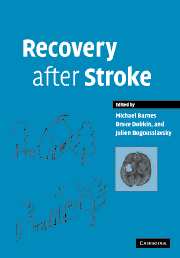Book contents
- Frontmatter
- Contents
- List of authors
- Preface
- 1 Stroke: background, epidemiology, etiology and avoiding recurrence
- 2 Principles of recovery after stroke
- 3 Regenerative ability in the central nervous system
- 4 Cerebral reorganization after sensorimotor stroke
- 5 Some personal lessons from imaging brain in recovery from stroke
- 6 Measurement in stroke: activity and quality of life
- 7 The impact of rehabilitation on stroke outcomes: what is the evidence?
- 8 Is early neurorehabilitation useful?
- 9 Community rehabilitation after stroke: is there no place like home?
- 10 Physical therapy
- 11 Abnormal movements after stroke
- 12 Spasticity and pain after stroke
- 13 Balance disorders and vertigo after stroke: assessment and rehabilitation
- 14 Management of dysphagia after stroke
- 15 Continence and stroke
- 16 Sex and relationships following stroke
- 17 Rehabilitation of visual disorders after stroke
- 18 Aphasia and dysarthria after stroke
- 19 Cognitive recovery after stroke
- 20 Stroke-related dementia
- 21 Depression and fatigue after stroke
- 22 Sleep disorders after stroke
- 23 Technology for recovery after stroke
- 24 Vocational rehabilitation
- 25 A patient's perspective
- Index
19 - Cognitive recovery after stroke
Published online by Cambridge University Press: 05 August 2016
- Frontmatter
- Contents
- List of authors
- Preface
- 1 Stroke: background, epidemiology, etiology and avoiding recurrence
- 2 Principles of recovery after stroke
- 3 Regenerative ability in the central nervous system
- 4 Cerebral reorganization after sensorimotor stroke
- 5 Some personal lessons from imaging brain in recovery from stroke
- 6 Measurement in stroke: activity and quality of life
- 7 The impact of rehabilitation on stroke outcomes: what is the evidence?
- 8 Is early neurorehabilitation useful?
- 9 Community rehabilitation after stroke: is there no place like home?
- 10 Physical therapy
- 11 Abnormal movements after stroke
- 12 Spasticity and pain after stroke
- 13 Balance disorders and vertigo after stroke: assessment and rehabilitation
- 14 Management of dysphagia after stroke
- 15 Continence and stroke
- 16 Sex and relationships following stroke
- 17 Rehabilitation of visual disorders after stroke
- 18 Aphasia and dysarthria after stroke
- 19 Cognitive recovery after stroke
- 20 Stroke-related dementia
- 21 Depression and fatigue after stroke
- 22 Sleep disorders after stroke
- 23 Technology for recovery after stroke
- 24 Vocational rehabilitation
- 25 A patient's perspective
- Index
Summary
Introduction
Cognitive manifestations of stroke depend primarily on the lesion location. The area of brain destruction partly depends on individual variations in vascular organization, but also on the type of stroke: ischemic stroke tends to produce lesions with relatively stable patterns, defined by the affected vascular territory. Hemorrhages produce damage beyond vascular territories with, nonetheless, preferential lesion distribution: spontaneous intracerebral hemorrhage preferentially occurs in deep structures (basal ganglia, thalamus) or in hemispheric lobes. By contrast, hemorrhage from aneurysm rupture occurs with the arteries at the base of the skull, thus producing specific syndromes, although definitive lesion extension may widely vary with vascular spasms.
The brain's division into vascular territories is only partially congruent with its subdivision in functional neural networks and circuitries. The consequence is that cognitive syndromes caused by ischemic lesions (Table 19.1) are rarely pure and, frequently, several functional systems can be involved (McNeil et al., 1991; Posner, 1995; Robertson, 2001).
It would be beyond the scope of this chapter to discuss in depth the cognitive syndromes occurring after stroke. We will discuss the typical cognitive failures associated with stroke in different cerebral areas as shown in Fig. 19.1 (Schnider, 1997) and then we will focus on some aspects of recovery of the main cognitive disorders occurring after stroke.
Localization of cognitive failures
Prefrontal lesions
Whereas damage of the posterior part of the frontal lobes (motor strip) gives rise to motor syndromes, damage of the area in front of and below the motor strip often produces cognitive and intellectual problems. The prefrontal cortex (Fig. 19.1, area 1) can be defined as the part of the frontal lobes receiving afferents from the dorsomedial thalamic nucleus (Fuster, 1997). It is eminently important for the ability to plan, initiate, and monitor actions; to concentrate on an action; and, at the same time, remain flexible to integrate new incoming information relevant for Behaviors (Fuster, 1997; Miller and Cohen, 2001). The precise cognitive failures emanating from prefrontal damage depend on the lesion location. At least three distinct syndromes can be distinguished (Stuss and Benson, 1986; Cummings, 1993). The first is seen in patients with lesions of the dorsolateral frontal region, following lobar hemorrhage or watershed infarct. They may manifest decreased drive, failure to recognize concepts, and lack of flexibility, together with perseveration and stereotyped motor behavior (e.g. grasping).
- Type
- Chapter
- Information
- Recovery after Stroke , pp. 503 - 537Publisher: Cambridge University PressPrint publication year: 2005
- 2
- Cited by



